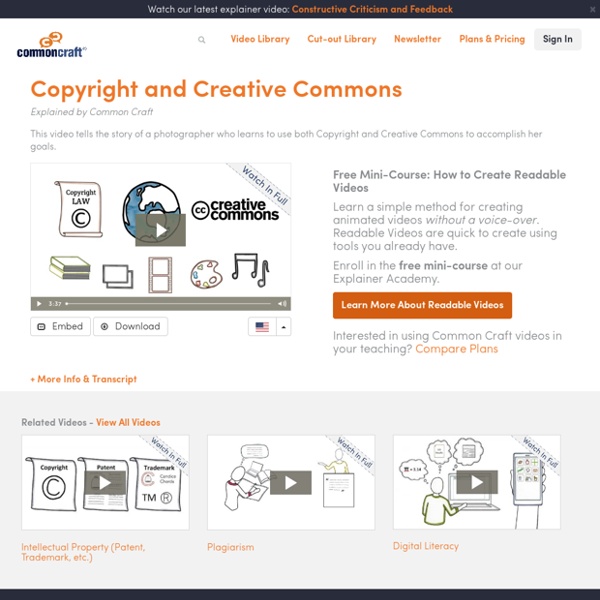12 Emerging Educational Uses of Technology That are the Most Exciting Right Now
Well, it's that time of year again … the start of a new school year. With it often comes the irresistible urge to make another list, or even better … many lists! Lists help us to plan, and they can also help us reflect and assess. One list I really enjoy putting together as we head into a new academic year is an updated look at which educational uses of technology have shown the most promise over the last year. Which tools and techniques most excite me as I look forward to another year of striving for continuous improvement as a teacher, technologist, and #edtech advocate? And as different technology uses take the spotlight, which of them are standing out a little less?
Educational Technology and Mobile Learning: copyright resources
August 12, 2014 Now that the new school year is about to start, it would be great to devote a session with your students where you can talk to them about issues related to copyright and proper use of digital artifacts from the net. This will definitely help them make better and informed decisions as to the kind of materials they are allowed to use in their work and provide them with practice on the different ways they can appropriately credit sources. This resourceful page embeds a wide variety of materials to use in this regard, browse through the items featured there and bookmark the ones you plan to use with your students.
What Is Creative Commons, And Should You Use It?
Advertisement While writing out your next academic paper, you look online for various images which are appropriate for what you’re talking about. Once you find something you like, you simply copy and paste it because, hey, who’s stopping you? More than likely, doing this is technically illegal. Not only that, but it applies to most content that you can find online — including posts/articles and videos.
Copyright-CopyWrong
The Educators' Lean and Mean No FAT Guide to Fair Use By Hall Davidson You can't afford to ignore the law, but neither can you afford to overlook the needs of your students.
What Is Creative Commons and Why Does It Matter?
As K-12 educators, you face unique challenges when it comes to using the Web. Not only are you trying to find resources to aid your teaching, but you're also on the lookout for resources that your students can use -- legally, technically, and socially. With so much out there, it can be difficult to figure out what is and isn't suitable for classroom use -- not to mention what will interest students long enough to tear them away from what’s trending on social media. One set of tools, known as Creative Commons licenses, can help address some of these challenges, while also enriching the teaching process and empowering learners of all ages. What are Creative Commons licenses?
Free To Use and Share: Resources To Help Teach Kids (and Adults!) About Copyright and Creative Commons
I've gotten a few requests lately for resources on how to teach kids (and adults!) about copyright. I've written before about how I don't think any lesson on copyright can be effective without an emphasis on creative commons and helping students choose licenses for their own work. Still, there are plenty of good resources out there to help start these conversations or that can serve as reminders as you help create a culture of creativity and attribution at your school.
About The Licenses
Our public copyright licenses incorporate a unique and innovative “three-layer” design. Each license begins as a traditional legal tool, in the kind of language and text formats that most lawyers know and love. We call this the Legal Code layer of each license.
From Cop to Counselor
Most of these columns, updated and edited, can be found in my book School Libraries Head for the Edge. Buy it and I might be able to afford a nicer nursing home one day. Thank you.
The Ultimate Copyright Guide for Students: Basics You Should Know
The Internet has brought the issue of copyright to the forefront like nothing else in history. The ease and speed with which people can share digital information has also made it very easy to commit copyright infringement, intentionally or not. In this guide, we cover copyright, plagarism, and the DMCA with specific references and insights for students. As a student, you have terabytes of data available literally at your fingertips, which makes project research and paper writing easier than they've ever been before. But it also means you must be more aware of copyright rules in order to avoid violating them.
Copyright and Primary Sources
How do I use the Restriction Statements that accompany the American Memory collections? The Library of Congress assesses materials for legal considerations prior to placing items online (see legal assessment). The Restriction Statement that accompanies each American Memory collection provides known information regarding ownership of materials in the collection. If known, we include contacts for permission. In some cases the Restriction Statement will indicate that material in a particular collection may be used freely; in other cases the Restriction Statement may only be a starting point for your inquiry.
FAQs About Copyright
Following are answers to some of the questions that school librarians and media specialists encounter frequently. What is covered by copyright law? Almost every original work is copyrighted immediately upon creation in tangible form.
Taking the Mystery Out of Copyright
skip navigation Library of Congress Teachers Suggestions enabled. The Library of Congress > Teachers > Classroom Materials > Presentations and Activities > Copyright



